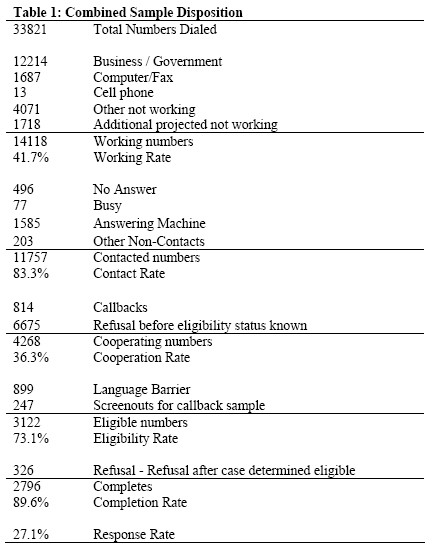The results in this report are based on data from telephone interviews conducted by Princeton Survey Research Associates International between June 27 to September 4, 2007, among a sample of 2,796 adults, 18 and older. For results based on the total sample, one can say with 95% confidence that the error attributable to sampling is plus or minus 2.5 percentage points. For results based Internet users (n=1,702), the margin of sampling error is plus or minus 3.1 percentage points. For results based on low-access Internet users (n=1,579) the margin of sampling error is plus or minus 3.3 percentage points. In addition to sampling error, question wording and practical difficulties in conducting telephone surveys may introduce some error or bias into the findings of opinion polls.
Two separate samples were used for interviewing. The main sample yielded 2,063 interviews. This RDD consolidated sample was drawn disproportionately from areas in the country with higher than average numbers of African-American and Latino residents. In order to increase the number of low-access Internet users in our sample, an additional 733 interviews were conducted with respondents from low-access households that were identified in previous PIAL surveys.
Sample was released for interviewing in replicates, which are representative subsamples of the larger sample. Using replicates to control the release of sample ensures that complete call procedures are followed for the entire sample. At least 10 attempts were made to complete an interview at sampled households. Calls were staggered over times of day and days of the week to maximize the chance of making contact with potential respondents. Each household received at least one daytime call in an attempt to find someone at home. In each contacted household, interviewers asked to speak with the youngest male currently at home. If no male was available, interviewers asked to speak with the youngest female at home. This systematic respondent selection technique has been shown to produce samples that closely mirror the population in terms of age and gender.
Non-response in telephone interviews produces some known biases in survey-derived estimates because participation tends to vary for different subgroups of the population, and these subgroups are likely to vary also on questions of substantive interest. In order to compensate for these known biases, the sample data are weighted in analysis. The demographic weighting parameters are derived from a special analysis of the Census Bureau’s March 2006 Annual Social and Economic Supplement Survey. This analysis produces population parameters for the demographic characteristics of adults age 18 or older, living in households that contain a telephone. These parameters are then compared with the sample characteristics to construct sample weights. The weights are derived using an iterative technique that simultaneously balances the distribution of all weighting parameters. The sample weighting also corrects for the disproportionate consolidated sample design.
Following is the full disposition of all sampled telephone numbers:

PSRAI calculates a response rate as the product of three individual rates: the contact rate, the cooperation rate, and the completion rate. Of the residential numbers in the sample, 83 percent were contacted by an interviewer and 36 percent agreed to participate in the survey. Seventy-three percent were found eligible for the interview. Furthermore, 90 percent of eligible respondents completed the interview. Therefore, the final response rate is 27 percent.




